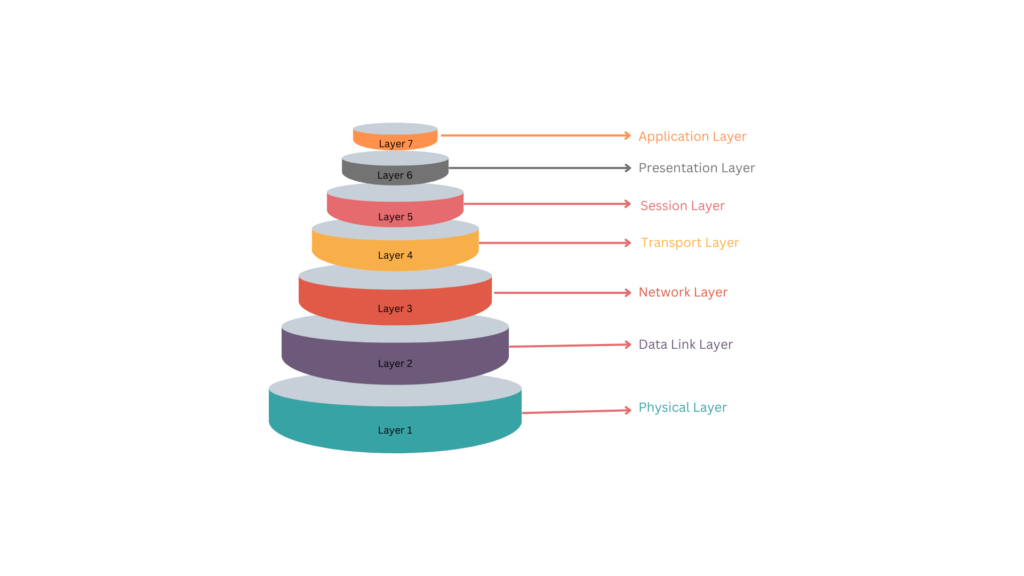The OSI Model - The Seven Layers Explained

The Open Systems Interconnection (OSI) model is a conceptual framework used to understand and standardize the functions of a telecommunications or computing system without regard to its underlying internal structure and technology. Its design is structured into seven distinct layers, each with a specific role in the process of transferring data from one system to another. These layers facilitate modular troubleshooting by allowing network administrators to isolate and address issues at a specific layer, enhancing the efficiency and reliability of network diagnostics.
In the context of data transmission, the OSI model employs a rule where each layer on the source side (the sender) engages in communication with its equivalent layer on the destination side (the receiver). This layer-to-layer interaction ensures that data packets are processed in a uniform manner across both ends of the communication line. For instance, the Data Link layer, which is responsible for node-to-node data transfer and error correction at the link level, one device will directly communicate with the Data Link layer on another device. This direct correspondence between identical layers across the communication stream ensures data integrity and consistency, thereby facilitating seamless and dependable data exchange. This organized approach to data handling allows networks to operate smoothly, supporting a wide range of applications and services.
Layer 1: Physical
This layer is primarily concerned with the tangible elements of network communication, including the hardware and the physical media that facilitate the movement of data across devices. As the initial and most foundational layer of the OSI model, the Physical layer plays a pivotal role in the transmission of digital information.
Key aspects of the Physical layer include:
- Signal Conversion: It is responsible for transforming digital data into various forms of signals — electrical, optical, or radio — depending on the medium of transmission. This conversion is crucial for enabling the physical movement of data between devices on a network.
- Connection Interfaces: The layer manages the physical connection points, such as network ports, which serve as gateways for data to enter and exit devices. These ports are vital for establishing and maintaining network connections.
- Transmission Rate and Distance: The Physical layer determines the speed at which data is transmitted and the maximum distance it can cover. These parameters vary based on the types of cables and technologies employed, affecting the efficiency and scope of data communication.
- Signal Integrity: Maintaining the quality of the data signals over the course of their journey is a critical function of this layer. It ensures that data is delivered accurately to its destination, free from errors and interference.
In essence, the Physical layer is dedicated to the infrastructure and physical components that underpin data transmission. It lays the groundwork for the seamless exchange of digital information by addressing the practical and mechanical aspects of network communication.
Layer 2: Data Link
Layer 2 of the OSI model termed the Data Link layer, plays a crucial role in the networking framework, particularly in the context of Ethernet networks. It is tasked with overseeing the direct transfer of data between adjacent network nodes and is instrumental in structuring communication at a more granular level compared to the Physical layer.
Key Functionalities of the Data Link Layer Include:
- Data Packetization: This layer segments digital data into packets, organizing them into a standardized structure. Each packet encompasses the payload (the actual data intended for transmission) and additional metadata for routing, error detection, and control information. This structured approach to data handling facilitates efficient and reliable data transmission.
- Addressing with MAC Addresses: A pivotal component of the Data Link layer's operation is the use of Media Access Control (MAC) addresses. These unique identifiers, akin to a postal address for physical mail, enable the layer to direct data packets to the correct endpoint within a network. Every device connected to the network possesses a distinct MAC address, ensuring precise and directed communication.
- Network Traffic Management: Devices such as switches and bridges operate within this layer, acting as the network's traffic managers. They analyze the data packets' MAC addresses and make decisions on how to forward them through the network to reach their destination efficiently. This involves directing traffic to avoid congestion and ensuring that packets are delivered through the most appropriate paths.
- Error Detection and Handling: Beyond simply transmitting data, the Data Link layer is also responsible for maintaining data integrity. It employs various mechanisms to detect and correct errors that may occur during transmission. This ensures that the data received at the destination is accurate and uncorrupted, maintaining the reliability of network communications.
In summary, the Data Link layer serves as the linchpin for data packet organization, addressing, and error management within a network. It ensures that data packets are correctly formatted, addressed, and transmitted between devices on the same network, while actively managing and correcting transmission errors to uphold the integrity of the data.
Layer 3: Network
The Network layer, akin to a sophisticated GPS system for data packets, is responsible for determining the most efficient route for data to traverse from its origin to its destination across interconnected networks. It ensures that data is routed correctly through complex network architectures.
Key Features:
- Logical Addressing: Assigns IP addresses to data packets, serving as unique identifiers similar to street addresses, guiding data to its correct destination across the internet.
- Inter-networking: Facilitates communication between disparate networks, enabling data to move from local networks to the global internet.
- Subnetting: Improves network management and security by segmenting larger networks into smaller, manageable sub-networks.
- Routing: Determines the best path for data to follow, optimizing the journey of data packets based on network conditions and topology.
Layer 4: Transport
The Transport layer is responsible for the reliable transmission of data segments between points on a network, ensuring that data is delivered in sequence and without errors. It's like the logistics service of the OSI model, breaking down data into manageable packets and ensuring they arrive safely.
Key Features:
- End-to-End Communication: Manages data transmission sessions between devices, ensuring accurate data transfer.
- Segmentation: Divides larger data streams into smaller segments for easier handling and reassembles them at the destination.
- Flow Control: Regulates data transmission to prevent overwhelming the receiver, ensuring a smooth data flow.
- Error Handling: Detects and corrects errors that may occur during data transmission, ensuring data integrity.
Layer 5: Session
The Session layer establishes, manages, and terminates connections between applications. It's like a moderator for communications, ensuring that sessions are maintained and properly closed after data exchange.
Key Features:
- Session Management: Controls the dialogues (sessions) between computers, establishing, maintaining, and ending connections as needed.
- Synchronization: Adds checkpoints in data streams to allow for the resumption of data transfer after a disruption.
Layer 6: Presentation
The Presentation layer acts as the translator for the network, converting data into a format that can be understood by both the sending and receiving applications. It's concerned with the syntax and semantics of the information transmitted.
Key Features:
- Data Formatting: Translates data from a format used by the application layer into a common format at the sending station and then back into the application's format at the receiving station.
- Encryption and Compression: Provides data encryption for security and data compression for efficient transmission.
Layer 7: Application
The Application layer is where end-users interact with computers, serving as the window through which networking services are accessed. It supports application and end-user processes, facilitating communication between software applications and lower layers of the OSI model.
Key Features:
- Resource Sharing: Facilitates access to network resources and services like file transfers, messaging, and email.
- Remote File Access: Enables users to access files and directories on remote computers.
- Directory Services: Provides a framework for naming and addressing that locates resources and devices on a network.
- Network Management: Supports applications that require network access and management capabilities.
In essence, the OSI model delineates the roles and functions of different network layers, from the physical transmission of data to the application-level interactions that users engage with. Understanding each layer's responsibilities provides insight into the complexities of network communication and the protocols that keep us connecte
